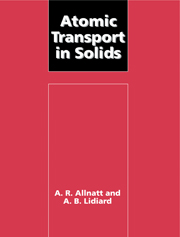Book contents
- Frontmatter
- Contents
- Preface
- List of principal symbols
- 1 Atomic movements in solids – phenomenological equations
- 2 Imperfections in solids
- 3 Statistical thermodynamics of crystals containing point defects
- 4 Non-equilibrium thermodynamics of atomic transport processes in solids
- 5 Some applications of non-equilibrium thermodynamics to solids
- 6 Microscopic theories – the master equation
- 7 Kinetic theory of relaxation processes
- 8 Kinetic theory of isothermal diffusion processes
- 9 The theory of random walks
- 10 Random-walk theories of atomic diffusion
- 11 Transport coefficients of dilute solid solutions – results and applications
- 12 The evaluation of nuclear magnetic relaxation rates
- 13 Theories of concentrated and highly defective systems
- References
- Index
2 - Imperfections in solids
Published online by Cambridge University Press: 28 December 2009
- Frontmatter
- Contents
- Preface
- List of principal symbols
- 1 Atomic movements in solids – phenomenological equations
- 2 Imperfections in solids
- 3 Statistical thermodynamics of crystals containing point defects
- 4 Non-equilibrium thermodynamics of atomic transport processes in solids
- 5 Some applications of non-equilibrium thermodynamics to solids
- 6 Microscopic theories – the master equation
- 7 Kinetic theory of relaxation processes
- 8 Kinetic theory of isothermal diffusion processes
- 9 The theory of random walks
- 10 Random-walk theories of atomic diffusion
- 11 Transport coefficients of dilute solid solutions – results and applications
- 12 The evaluation of nuclear magnetic relaxation rates
- 13 Theories of concentrated and highly defective systems
- References
- Index
Summary
Introduction
In the preceding chapter we reviewed a number of properties of crystalline solids which demonstrate the movement and migration of atoms through these solids. The atomic theory of these properties is the subject of this book, and in this chapter we review the relevant basic mechanisms. Fundamental to these are questions of structure, both the ideal lattice structure of the perfect crystal, as one would determine it by X-ray or neutron diffraction, and those local modifications of this crystalline arrangement of atoms, called imperfections or defects, which facilitate this movement of atoms through the body of the crystal. Mostly we shall be dealing with systems in which the fraction of atoms contained in imperfect regions of the crystal is small, i.e. we are dealing with nearly perfect crystals. Notable exceptions, which we shall consider to varying degrees in this and later chapters, include order–disorder alloys, fast ion conductors and concentrated solutions of hydrogen in metals.
There are two important and interesting general facts about these crystal imperfections. This first is that there is not an arbitrary number of distinct types, but just a few. This is true for topological reasons even if we represent the solid as a continuum, when we would classify the elementary imperfections as point defects, dislocations (linear) and surfaces (two-dimensional). In a crystal lattice there are others, such as stacking faults and grain boundaries, for which there are no analogues in a continuum, but the total number of distinct types remains small. The second general fact is that the same classification of imperfections is useful irrespective of the type of bonding between the atoms of the solid.
- Type
- Chapter
- Information
- Atomic Transport in Solids , pp. 50 - 91Publisher: Cambridge University PressPrint publication year: 1993
- 1
- Cited by



